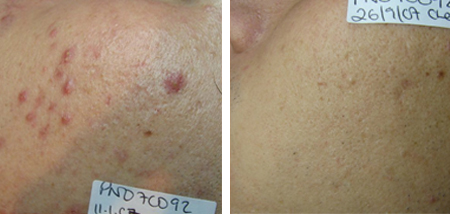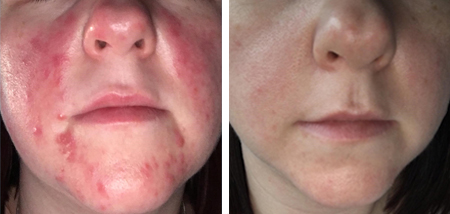Procedure Time
20 – 30 minutes
No. of treatments
6 sessions
Downtime
No real downtime
Results
leaving you with clear skin
Price
Starting from £95
Book Free Consultation
Why Consider Acne Treatment?
- Do you have to cake your acne skin with makeup daily?
- Are you so conscious that you can’t let anyone see you without your mask or makeup?
- Do you feel insecure in your own skin? Do you feel like you don’t want other people to be around you and you want to keep to yourself?
- Don’t become an introvert-related to your Acne. Don’t let Acne stop you doing things that you normally would do.
- We want you to feel better about yourself. Take Control its time for a Change!
- Get your self-confidence back with our 3 month Acne treatment plan.
Results from Acne Treatment
- Reduces the number and severity of active lesions, lessening the inflammation and frequency of acne breakouts.
- Clearer skin, the treatments will improve the complexion by reducing the scarring left by Acne and provide an even skin tone.
- Reduces the need to wear tons of make-up to conceal the spots and scarring.
- Gives you your self-confidence back.
Why choose us?
- We offer an individualised combined approach to treat Acne. Every skin is a little bit different and sometimes it takes more than one treatment type to get good results.
- We offer the most optimum light systems to kill bacteria causing Acne.
- We have seen over 40% reduction in Acne in 6 treatments.
- Most of our clients are referred to by friends and family.
- We offer the most competitive prices without compromising on quality.
3 Easy steps to Acne Free Skin
Acne Free Consultation
This is a Free consultation with your skin practitioner to check they type and severity of your Acne and recommend an individualised treatment plan.
Acne Free Treatment
The treatment is performed by our trained and certified Skin practitioners.
Acne Homecare
The Acne homecare products should be used to enhance the in-clinic treatments and to maintain results.
Before & After


Special Offer
IPL Acne Treatment
- 6 Sessions £384
More Information
How does Intense Pulsed Light (IPL) work?
- The light emitted from the Intense Pulsed Light system directly targets overactive sebaceous glands, greatly reducing the total number and severity of active lesions, and lessening the inflammation and occurrence of break-outs. The light stimulates the production of new collagen to improve skin texture, and can also reduce the appearance of red or brown areas of skin that are often associated with acne breakouts.
Who is suitable for the treatment?
- This is a safe procedure which can be performed on Men and Women including teenagers suffering from mild to moderate Acne.
- It is not a suitable treatment for very dark skin.
- If you have cystic Acne this treatment is not suitable, and it may be advisable to see a dermatologist.
Who is not suitable for the treatment?
- Cancer
- Pregnancy
- Very dark skin
- Sun tan/use of sun beds and fake tan
- Healing disorders such as those caused by Diabetes Mellitus and lupus
- History of Keloid scarring
- Pigment disorders such as Melasma
- Recent use of Roacutane
- Immune, lymphatic system disorders
Consultation procedure
- Prior to the treatment, you must first undergo a consultation where details about your medical history are obtained in order to confirm suitability. Before proceeding, you will be asked to sign a consent form and undergo a test patch.
What steps are involved in the treatment?
- Your skin is cleansed & Massaged with the highest strength of Salicylic Acid, this will prepare the skin for IPL/Laser. It will bring the skin to PH balance without being abrasive or irritating on the skin.
- An oxygen infusion treatment is then carried out. An oxy infusion cream is applied with a Catalase Anhydro Gel which helps with the destruction of peroxides & helps soften & exfoliate the skin.
- A layer of chilled gel is applied to the skin to help guide the light. The light guide is placed onto the skin and a short pulse of light is released. The applicator is passed over the skin several times before moving onto the neighbouring area and the process is repeated until the whole area is treated. Each pulse of light treats a large area of skin and so the duration of the treatment is very short.
- The gel is removed and a Menthol Mask is applied onto the skin.
- The treatment is finished off with an antibacterial peptide cream.
- Your skin will be left feeling cleaner and clearer with inflammation & redness reduced.
- There is no down-time involved, you do not need to give your skin time to heal.
How long does the treatment take?
- A typical treatment session is approximately 20-30 minutes.
How does the treatment feel?
- Treatment is mildly uncomfortable but no anaesthesia is required. All of our patients tolerate the treatment very well and some find the treatment relaxing.
How many treatments are required?
- The treatment is done gradually over a period of time, although you will see results after the first session.
- We recommend a minimum of 6 treatments spaced out every 2 weeks.
- Tailored homecare products recommended by the therapist should be used to enhance the clinic treatments.
Are there any possible side effects?
- Your skin will be slightly red and tender after the treatment. other than that there’s no real downtime involved.
- We do not treat very dark skin as there may be risks of complications such as hyper & hypo-pigmentation.
- On Male clients there may be some hair removal that could be permanent.
About Acne
The term Acne refers to the process that can result in as little as one blackhead or to be as much as the severe cystic acne. It is a disorder of the skin’s sebaceous glands and is believed to be an inherited condition caused by a genetic defect.
Which areas of the body can Acne affect?
Over 90% of people with Acne have facial Acne, 60% have Back acne and chest Acne. Severe acne can occur on the face, back and chest.
What age does Acne occur?
- Acne starts most frequently at around the age of 12, with females starting earlier than males due to the earlier onset of puberty, however can appear as early as age 8 or 9.
- The peak acne years are 14-17 in females and 16-19 years in males. As many as 40% of females and 35% of males are affected during these years.
Teenage Acne
- Acne occurs due to increased levels of the hormone called testosterone, which occurs during puberty. The sebaceous glands are sensitive to these hormones, the glands produces more sebum which results in Acne.
Adult Acne
- Some women even get Acne for the first time at the age of 30 or 40. There are many reasons you can break out as an adult. Stress or changes in your hormone levels like menopause or switching or stopping birth control pills are some possibilities.
- PCOS which is a hormonal imbalance can also cause Acne.
- In adults Acne can cause psychological problems such as anxiety and depression. Adults may be more conscious of their Acne because it is called a ‘disease of teenagers’.
Types of Acne
Acne is classified into groups based on treatment and increasing levels of severity and scarring.
| Grade 1 = Mild | Non inflammatory non-scarring acne with open and closed comedones only. |
| Grade 2 = Moderate | Inflammatory and noninflammatory non-scarring acne with open and closed comedones and some papules and pustules. |
| Grade 3= Severe | Inflammatory acne and noninflammatory acne with open and closed comedones and extensive papules and pustules. |
| Grade 4= Very Severe | Very inflammatory scarring acne and non inflammatory acne with open and closed comedones, papules, pustules, nodules and cysts. |

Acne scarring
Acne can result in lifelong scarring and pigmentation abnormalities.
Pitted Scarring, Dish Shaped Scars
- Pitted acne scarring is deep and resembles the type of scar that might occur if the face were stabbed with an ice pick. Unfortunately this type of scar is very difficult to correct with cosmetic treatment.
- Dish-shaped scars are broader that they are wide and can be minimized with a variety of cosmetic procedures including dermabrasion, subcision, and the injection of fat or fillers.
Pigmentation
- Acne can result in long-lasting colour changes of the face. This can be prolonged redness from intense inflammation or pigmentation from damage to the melanocytes. Especially in darker skin types acne can induce postinflammatory hyperpigmentation, which appears as brown or brownish-black spots on the face.
- This type of hyperpigmenation can be corrected with our skin peels and homecare treatment plan.
- If the acne lesion is highly inflammatory, the pigment can be destroyed, and a white scar may be present. It is not possible to re-pigment a white acne scar.
- Nodular and cystic acne can result in lifelong scarring, which results in uneven facial skin texture.
Acne Treatment
Although Acne cannot be cured, the major goal of treatment is to prevent permanent scarring and to decrease the redness and pigmentation that occur following healing of acne lesions.
What Causes Acne?
- While a great deal is known about Acne, the primary cause still is not known and thus there is no cure for acne.
Overactive sebaceous glands
- There can be no acne without sebum and this requires an active sebaceous gland. Sebum forms a protective coating over the skin surface and preserves the skin barrier by preventing water evaporation from the skin surface to the environment. However, sebum is necessary for acne and the amount of sebum produced correlates with the severity of the acne.
- There are several factors that drive sebum production. One of the major driving factors is male hormones, known as androgens, which explains the increased severity of acne found in males rather than females. However, the androgenic balance is abnormal in 50-75% of females with acne. Some women have a hormone imbalance due to polycystic ovary disease, where the ovarian hormone production is abnormal.
Bacteria
- The excess sebum production clogs the openings of the hair follicles. Bacteria then grow in these follicles.
- The outer horny layer of the epidermis is usually dead. It is constantly shedding thousands of keratinised cells.
- We are unaware of it because the cells are microscopic in size.
- The surface of the face is covered with sebaceous follicles that are long hollow tubes not much bigger in diameter than a hair. The walls of the follicle are lined with the same dead cells that are on the outside of the face. Hence the same constant shedding takes place in the sebaceous follicle.
- Normally glue like substance, called intercellular glue, carries these dead cells to the surface where they are eventually shed. However, in people who are genetically prone to acne, these cells stick together in the follicle and cannot reach the surface and cause a blockage called micro comedones.
- At this stage the process is developing in the follicle only and the surface of the skin may appear entirely clear and unaffected. As the process continues, the blockage worsens and oils and bacteria build up. The bacterium subsequently excretes a nasty inflammatory acid by-product that leads to various acne lesions.
-
Open Comedones (Blackheads)
In order to accommodate the accumulation of dead cells and oils the follicle forces the opening wider and appears as enlarged pores or blackheads.
-
Papules/Pustules/Nodules/Cysts
Should the opening of the follicle be closed, the blocked follicle will expand to accommodate the increasing accumulation of dead cells/oil/fatty acids/bacteria may progress into a papule/pustule/nodule/cyst.
- The follicle will continue to expand until it looks like a little bulging round ball. Follicles at this stage can only stretch so far and can be categorised as time bombs ready to explode. Stress, menstrual cycle, lack of sleep and other factors provide the trigger for the bomb to explode. This explains one of the reasons why the acne is frustratingly inconsistent.
- As the time bomb explodes, the contents of the follicle leak out into the surrounding tissue causing severe inflammation. After the infection has subsided, the severity of the lesion and the scarring of the skin depend on the size and contents of the ruptured follicle.
- The most severe eruption is the cyst that occurs when a follicle ruptures in the dermis to cause destruction of collagen and elastine leading to superficial scarring or deep pitting on the skin.
What Our Clients Say
Related Treatments
Our Clinics
Central London
Expert Centre,
31-32 Eastcastle Street,
London W1W 8DL
Monday to Friday:
9am - 8pm
Saturday & Sunday:
10am - 6pm

Tube Station:
Oxford Circus
Colindale Clinic
12 Holmstall Parade,
Colindale
HA8 5HX
Monday to Friday:
9am - 8pm
Saturday & Sunday:
10am - 6pm






Tube Station:
Burnt Oak
Chiswick Clinic
36 Devonshire Road,
Chiswick,
W42HD
Monday to Friday:
9am - 8pm
Saturday & Sunday:
10am - 6pm






Tube Station:
Turnham Green
Maida Vale Clinic
4 Sutherland Avenue,
London
W9 2HQ
Monday to Friday:
9am - 8pm
Saturday & Sunday:
10am - 6pm






Tube Station:
Royal Oak, Warwick Ave,
Maida Vale
Tower Hill London
50 Mark Lane
First Floor
London
EC3R 7QR
Monday to Friday:
9am - 8pm
Saturday & Sunday:
10am - 6pm






Tube Station:
Tower Hill (2 Min),
Fenchurch Street (4 Min),
Monument (5 Min),
Bank(9 Min),
Temple(10 Min)


